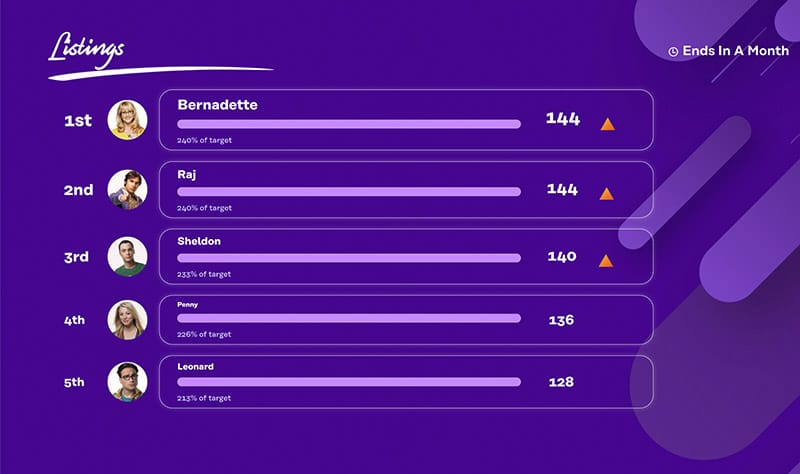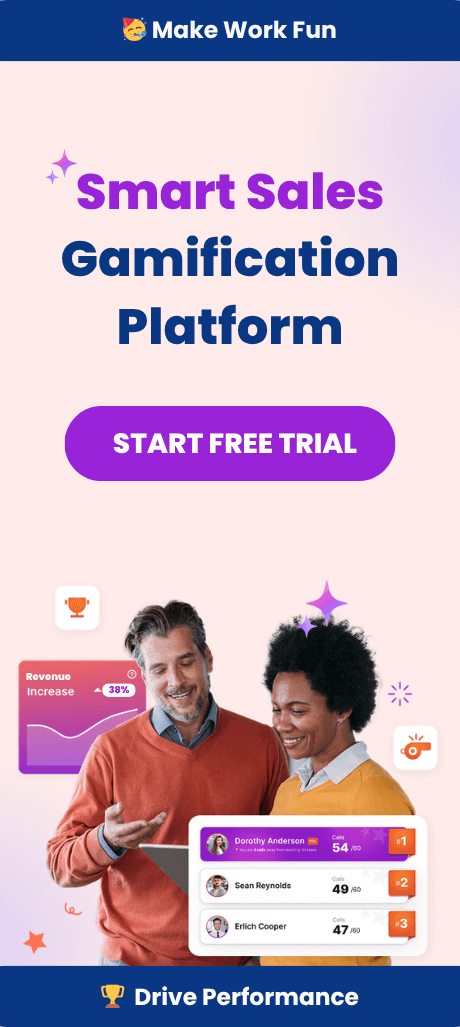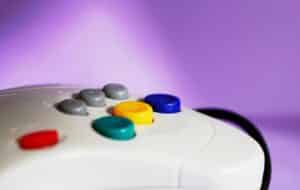New year, new sales strategies!
The best way to find sales success in 2025 is to find innovative ways to keep your team engaged and entertained with motivational gaming techniques. With the help of gamification and gamification software, you can help your sales reps adjust their approach to their day-to-day, leading to more sales, revenue, engagement, and more.
In this article, we’ll explore different ways to use game elements in your 2025 sales strategy to drive business growth and enhance digital marketing strategies. You can then use these gamified sales strategies to make meaningful adjustments to the workplace experience for your team.
Here’s how to use gamification as a sales performance enhancement:
What is Gamification?
Gamification is the process of incorporating game elements in non-game contexts. With mini competitions, leaderboards, and data-driven tools, you can keep your sales team engaged with their work tasks the same way they stay engaged with their video games outside of work.
There are many gamification benefits you can look forward to once you’ve made it part of your day-to-day life. This includes increased engagement, motivation, and communication. With the right strategies, you can also keep all of your team members on task and help them with setting goals.

Small gamified adjustments can help them stay motivated, creative, and innovative while they work on their everyday tasks. To successfully include game elements into your sales process, you’ll just need the right gamified tools and software.
Essential Game Elements for Success
Game elements are the building blocks of a successful gamification strategy. They are the interactive components that engage users and motivate them to achieve specific goals. Here are some essential game elements that can drive your success:
- Rewards: Providing rewards for achieving specific milestones or completing tasks is a powerful motivator. Whether it’s a tangible prize or a simple acknowledgment, rewards can significantly boost morale and drive performance.
- Points: Point systems can be used to track progress and provide a sense of accomplishment. By earning points for completing tasks, sales reps can see their efforts translate into measurable success, fostering a sense of achievement.
- Leaderboards: Leaderboards foster competition and encourage users to strive for excellence. By displaying top performers, leaderboards create a healthy competitive environment that motivates everyone to improve their performance.
- Badges: Badges provide a visual representation of achievements and can be used to unlock new content or features. They serve as a form of recognition and can be a great way to celebrate milestones and accomplishments.
- Challenges: Challenges provide an opportunity for users to test their skills and abilities. By setting up specific tasks or goals, challenges can keep the team engaged and focused on continuous improvement.
Incorporating these game elements into your sales strategy can transform mundane tasks into exciting opportunities for success.
How to Incorporate Game Elements Into Your Sales Strategy
Dynamic gamification strategies can be customized to help you achieve sales targets and KPIs. There are many ways to successfully use game elements in the workplace to inspire and motivate your team. Game design elements contribute to enhancing user engagement and behavior modification by incorporating game mechanics and dynamics, which are essential for fostering customer loyalty and motivation.
Here’s seven ways to get started:
Boost Engagement With Game Mechanics

Gamification, a key component in modern sales strategies, is not just interactive and fun, but also a powerful tool to enhance team performance. Spinify takes this concept to the next level, perfectly blending entertainment with productivity. By introducing sales games, your sales team can explore new dimensions in prospecting, renewals, and lead generation in a way that’s both engaging and results-driven.
Game dynamics serve to fulfill players’ fundamental needs and desires, motivating engagement and behavioral change. Popular games and sales engagement tactics such as cold calling contests, weekly revenue sales contests, prize wheels, leaderboards, and time-bound challenges are effortlessly integrated into Spinify. These gamified elements are not just about competition; they’re about bringing a sense of achievement and recognition to everyday tasks.
Spinify elevates these experiences by offering customizable options to suit your team’s unique dynamics. Whether it’s setting up a cold calling contest or a complex multi-stage sales challenge, Spinify’s intuitive platform makes it easy and effective. You can plan games tailored to different objectives like upselling, demo scheduling, or new client acquisition. This varied approach ensures that even the most mundane tasks become opportunities for engagement and success.
What sets Spinify apart in the realm of sales gamification is its ability to seamlessly integrate with your existing CRM and sales tools. This integration ensures that your sales data is always up-to-date, enabling real-time tracking and leaderboards that reflect current achievements and standings. This immediate feedback loop is crucial in maintaining high energy and motivation levels among your team.
Moreover, Spinify’s analytics provide insightful data, helping you understand what motivates your team and how they perform under different gamified conditions. This allows for continuous improvement in your sales strategies, making sure they align with your team’s strengths and market demands.
2. Improve Communication With Team Building Games

Are you struggling with team building and collaboration? Are you finding it challenging to keep a remote workforce connected and engaged? Don’t worry, we’ve all been there.
Strong relationships with clients are crucial, and tailored solutions can significantly enhance team collaboration. One paint point many sales teams in Saas, tech, or marketing struggle with is marketing and sales alignment. A great way to improve communication and inspire collaboration is to plan team-building games and activities. Some popular options include:
- Ice breakers
- Escape rooms and scavenger hunts
- Point systems and leaderboards
- Trivia sessions
- Happy hours
- Charades
These games use gamification to keep everyone connected. While it may seem like just a silly round of trivia during lunch or a scavenger hunt, these gamified opportunities can enhance the workplace dynamic – for the better.
3. Use Data to Revise Your Sales Strategies
Data is vital to finding new opportunities. If your team doesn’t have access to data, sales trends, and analytics, it can be challenging to find ways to improve your sales strategy in 2025. Data dashboards and gamified technology can help supercharge your team’s sales engagement strategies and provide an inside look into the pain points and opportunities.

By utilizing proven strategies, you can craft solutions that are both compliant with industry regulations and beneficial for clients’ goals.
You can also take a closer look at KPIs such as:
- Renewal rate
- Churn rate
- Monthly sales growth
- Average sales booking
- Monthly phone calls per sales rep
- Monthly emails per sales rep
With this data, you can personalize your team’s approach to their sales strategy, helping them make meaningful adjustments to the workplace dynamic.
4. Foster Healthy Competition With Leaderboards

Friendly competition keeps the workweek interesting. It’s a great way to keep your sales team engaged with their goals and to make mundane tasks easier to complete.
Our commitment to delivering positive outcomes through comprehensive and strategic planning ensures that your team not only meets their goals but also achieves measurable success.
Leaderboards are a visual game element that can help your sales reps visualize their own success. Whether you’re tracking revenue, emails sent to prospects, or demos booked week over week. With a leaderboard, you can switch up the competition and keep your team on their toes.
You can also use the leaderboards to create mini-games and competitions. Our Spinify leaderboards can be customized to align with a single goal or competition. We pull data from your tech stack and specific data sources to provide a fully personalized experience for your team. Sales reps can go head-to-head or partner up in a fun-filled multiplayer setting.
To enhance the workplace experience with competition-driven sales, you’ll want to:
- Actively reference the leaderboard during one-on-one and all-hands meetings
- Celebrate every accomplishment or small win
- Switch up the goals and competitions to ensure your team doesn’t get burned out
- Display the leaderboard on the big screen in the office
- Reward your team for their accomplishments
5. Turn Everyday Tasks Into Fun-Filled Activities
Gamification and game elements turn mundane tasks into fun activities. Using game elements like point systems, leaderboards, and games is a great way to avoid burnout and keep your team on task throughout 2025. Understanding and addressing the specific needs of each sales rep is crucial to creating tailored gamification elements that align with their unique situations.

The best way to use game elements to revitalize your sales strategy is to:
- Switch up contest themes on a weekly or monthly basis
- Personalize your gamification elements for each sales rep
- Integrate gamification and game elements with gamified sales engagement software
- Plan quarterly games and individual competitions for each sales rep
6. Reward Your Team For Their Contributions
Rewards inspire success. They are a must-have for keeping your team engaged with their goals and KPIs. A recent study on rewards and recognition shows that rewards programs produced a 27% gain in employee performance.
Utilizing stellar strategies to empower your team’s vision and drive growth through innovative rewards programs can significantly enhance their motivation and productivity.
If you aren’t already using rewards to keep your team engaged with tasks and goals, you might notice your team isn’t putting in enough effort to close deals or connect with more prospects.

Some innovative sales approaches to revamp your approach to rewards and gamification include:
- Set up a prize wheel your team can spin when they reach their goals
- Have a selection of prizes your team can choose from
- Highlight the rewards and prizes for every mini-game or leaderboard competition before you start playing
- Add a specific time frame for the game to spark urgency
7. Revamp Your Recognition Initiatives
Sales reps want to feel recognized for their contributions to the workplace. Studies suggest that productivity and engagement can be increased by over 14% for businesses with well-thought-out recognition programs.
Addressing the questions and concerns of key decision-makers is crucial to developing tailored recognition programs that adhere to business standards and governmental regulations.
If they start to feel like their contributions aren’t recognized, it can lead to burnout and low employee satisfaction. To ensure that every accomplishment is recognized, you’ll want to start by:
- Scheduling regular sales coaching calls
- Using point systems and leaderboards to track your team’s success
- Celebrate every win during weekly all-hands meetings or on Slack or Teams
Effective Game Mechanics for Engagement

Game mechanics are the rules and systems that govern the behavior of game elements. Effective game mechanics can significantly enhance engagement by creating a compelling and rewarding experience. Here are some key mechanics to consider:
- Variable Rewards: Providing variable rewards for completing tasks or achieving milestones can create a sense of anticipation and excitement. This unpredictability keeps users engaged and eager to see what they will earn next.
- Progress Bars: Progress bars provide a visual representation of progress and can motivate users to continue working towards a goal. Seeing their progress can encourage sales reps to push through challenges and stay committed to their objectives.
- Social Sharing: Allowing users to share their progress or achievements on social media can create a sense of community and encourage others to participate. This social aspect can amplify the impact of your gamification strategy and foster a supportive environment.
- Timed Challenges: Timed challenges can create a sense of urgency and encourage users to complete tasks quickly. By setting deadlines, you can motivate your team to stay focused and achieve their goals within a specific timeframe.
- Leveling Up: Leveling up can provide a sense of accomplishment and unlock new content or features. As users progress through levels, they can experience a sense of growth and development, which can be highly motivating.
Implementing these game mechanics can create an engaging and dynamic environment that keeps your team motivated and productive.
Creating a Stellar Gamification Strategy
Creating a stellar gamification strategy requires a deep understanding of your target audience and their motivations. Here are some tips for crafting a successful strategy:
- Identify Your Goals: Clearly define what you want to achieve with your gamification strategy. Whether it’s increasing sales, improving engagement, or enhancing team collaboration, having specific goals will guide your efforts.
- Know Your Audience: Understand what motivates and engages your target audience. Conduct surveys, interviews, or focus groups to gather insights into their preferences and interests.
- Choose the Right Game Elements: Select game elements that align with your goals and audience. Consider which elements will be most effective in motivating your team and driving the desired outcomes.
- Design a Compelling User Experience: Create a user experience that is engaging, intuitive, and rewarding. Ensure that the gamified elements are seamlessly integrated into your existing processes and tools.
- Test and Refine: Test your gamification strategy and refine it based on user feedback and data analysis. Continuously monitor the effectiveness of your strategy and make adjustments as needed to keep it relevant and impactful.
By following these steps, you can develop a gamification strategy that drives success and keeps your team motivated and engaged.
Overcoming Challenges in Gamification
Gamification can be a powerful tool for engagement and motivation, but it can also be challenging to implement effectively. Here are some common challenges in gamification and how to overcome them:
- Lack of Engagement: Encourage users to participate by providing clear instructions, feedback, and rewards. Make sure the gamified elements are relevant and appealing to your team.
- Poor Game Design: Ensure that your game design is engaging, intuitive, and rewarding. Invest time in designing a user-friendly experience that keeps participants motivated and excited.
- Limited Resources: Start small and scale up as needed. Focus on implementing a few key game elements and gradually expand your gamification strategy as you gain more experience and resources.
- Measuring Success: Use data analytics to measure the effectiveness of your gamification strategy. Track key metrics such as engagement, performance, and satisfaction to assess the impact of your efforts and identify areas for improvement.
By addressing these challenges, you can create a gamification strategy that is both effective and sustainable.
Future Trends in Gamification
Gamification is a rapidly evolving field, and several trends are expected to shape its future. Here are some of the most significant trends to watch:
- Artificial Intelligence: AI-powered gamification will become more prevalent, enabling more personalized and adaptive experiences. AI can analyze user behavior and preferences to tailor gamified elements to individual needs.
- Virtual and Augmented Reality: VR and AR will become more widely used in gamification, providing immersive and interactive experiences. These technologies can create engaging environments that enhance learning and performance.
- Blockchain: Blockchain technology will be used to create secure, transparent, and tamper-proof gamification systems. This can enhance trust and accountability in gamified processes.
- Mobile-First Design: Mobile-first design will become more prevalent, enabling gamification experiences that are optimized for mobile devices. As more users access gamified content on their smartphones, designing for mobile will be essential.
By staying ahead of these trends, you can ensure that your gamification strategy remains innovative and effective in the years to come.
The Only Sales Gamification Software You Need
We live in a world surrounded by distractions. The best way to ensure your sales reps, marketing managers, and customer success team are engaged with their day-to-day activities is to start implementing gamification sales strategies that can keep them on task during their 9-5. Spinify is a business consulting and sales gamification tool designed with your team in mind. With our tool, you can plan sales games, track your team’s progress, and keep everyone on track to reach their goals in 2025. Once you’ve fully integrated Spinify into your tech stack, your team will unlock access to innovative sales engagement tools that will help them take their sales strategies to the next level. Book a personalized demo here!




